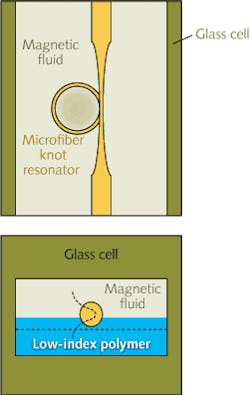FIBER-OPTIC SENSING: Microfiber knot becomes magnetic-field sensor
An all-optical-fiber magnetic-field sensor, consisting of a microfiber knot resonator (MKR) immersed in a magnetic fluid (MF), has been developed by scientists at Xi’an Jiaotong University (Xi’an, China).1 An MKR is made of optical fiber drawn down in diameter to allow evanescent waves, and is tied in a simple overhand knot; the proximity region allows evanescent coupling and creates a ring resonator cavity (in some cases with a very high quality factor Q).
Magnetic fluid is made up of single-domain ferromagnetic nanoparticles dispersed evenly in a carrier liquid; an MF can have magneto-optic properties. When the MKR is immersed in an MF, the evanescent field around the resonator penetrates into the MF, which in turn affects the resonator properties as the MF is affected by an external magnetic field.
A standard singlemode fiber was drawn down to a 4 μm diameter and knotted to form an MKR ring with a 510 μm diameter. Because the glass plate substrate has a refractive index higher than that for the fiber (potentially coupling evanescent waves away from the MKR), it was first coated with a 50-μm-thick layer of low-index polymer gel and cured.
A thinner (2 μm) polymer-gel layer was coated on the plate and the MKR laid upon it, then the polymer cured; this fixed the MKR into place while still allowing most of its surface to be free. Finally, the assembly was placed into a glass cell filled with a water-based MF with 10-nm-diameter magnetite particles at 0.5% concentration.
Light from a broadband superluminescent light-emitting diode (SLED) emitting in the 1545 nm spectral region was fed through the fiber; at the output end, an optical spectrum analyzer produced a spectral scan. With no external magnetic field applied, the Q factor of the resonator was determined to be about 12,400 and the free spectral range about 1.08 μm.
Changes in wavelength and transmission
For test, the assembly was placed in a Helmholz coil, which produces a uniform magnetic field in a region around its center (see figure). A range of magnetic-field strengths were applied, ranging from 0 to 600 oersteds (Oe). The resulting resonance spectra showed a shift toward longer wavelengths and a reduction in transmission as the magnetic-field strength was raised. A calibration curve was plotted, showing two regions, one approximately linear, reaching 90 pm wavelength shift at 300 Oe, and the other showing signs of saturation, reaching 100 pm at 600 Oe. The curve showed negligible hysteresis.
Next, an alternating magnetic field with 50 Hz frequency was applied; the sensor output as a function of time showed the same response when the magnetic field at a certain strength was negative or positive. It rectified the temporal curve of the alternating magnetic field. The response was approximately linear up to a field strength of ~300 Oe; the minimum detectable magnetic-field strength was about 10 Oe with a signal-to-noise ratio of ~3.
The researchers note that the setup can be sensitive to temperature, but they were able to reduce sensitivity by optimizing the microfiber diameter, refractive index, and thermo-optic coefficient of the polymer gel at values of 4 μm, 1.40, and -1.0 × 10-4, respectively.
REFERENCE
1. X. Li and H. Ding, Opt. Lett., 37, 24, 5187 (Dec. 15, 2012).
About the Author
John Wallace
Senior Technical Editor (1998-2022)
John Wallace was with Laser Focus World for nearly 25 years, retiring in late June 2022. He obtained a bachelor's degree in mechanical engineering and physics at Rutgers University and a master's in optical engineering at the University of Rochester. Before becoming an editor, John worked as an engineer at RCA, Exxon, Eastman Kodak, and GCA Corporation.

